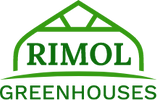Choosing a covering for your high tunnel or greenhouse is one of the most important steps in the greenhouse design process. For a high tunnel or freestanding greenhouse, you will need to choose a covering for your roof and for your end walls. For a gutter-connect greenhouse with a polycarbonate roof, you will need to consider polycarbonate vs. glass for your side and end walls. Here are some of the different options for greenhouse coverings and the benefits of each.
Four-Year Poly
Standard polyethylene sheeting, known commonly as “poly” or greenhouse plastic, is one of the most popular choices for a greenhouse covering. 6-mil poly is easy to work with and easy to install, and it contains UV block and an anti-dust additive. Poly can be used for both the roof and end walls of the greenhouse.

You can also upgrade to IR/AC Poly, which includes all the same features as standard four-year poly plus an additional additive that disperses light and helps to delay the exit of heat from the greenhouse during the night.
High tunnels can be covered in a single or a double layer of poly. If you choose to cover your high tunnel in double layer poly, a popular choice is to use IR poly for the inside layer, and then standard four-year poly for the top layer. The IR inner layer helps retain heat at night, resulting in a 20-25% energy gain over conventional film. IR poly is also used as an inner layer because it contains an additive resulting in an “anti-drip” feature.

Learn more: Choosing Single vs. Double Poly for Your High Tunnel Covering
Greenhouse poly typically needs to be replaced every 4-6 years, depending on weather and wear-and-tear. If you are replacing your greenhouse poly, follow our tips for a smooth installation process.
Reinforced Woven Poly
If you are looking for a stronger covering that is still cost-effective and easy to install, consider reinforced woven poly. Woven poly is made of UV-resistant woven polyethylene, and it is designed to be more durable than standard poly sheeting. It is tear-resistant and long-lasting, making it an ideal choice for end walls on high tunnels. It can also be used on the roof as a stronger second layer of poly.


Polycarbonate
Polycarbonate is the most durable and long-lasting choice for a greenhouse covering. Polycarbonate sheets are virtually unbreakable, yet also lightweight and highly flexible, making them easy to install on a greenhouse. Polycarbonate panels provide up to 80% light transmission in clear and can last for 10-20 years or more without needing to be replaced.

Multi-wall polycarbonate also provides the best heat retention due to its insulative properties. For high tunnels, polycarbonate end walls can be a smart choice that helps save energy and maintain light transmission for optimal growing conditions.
Some greenhouse growers also choose to use polycarbonate for a roof covering. This is a great choice for greenhouses at schools or other institutions that require durability and longevity. Polycarbonate sheets are classified as self-extinguishing, so their flammability rating will meet safety standards at schools and other institutions.

All of Rimol’s Matterhorn gutter-connected greenhouses use a polycarbonate roof. This provides the ultimate strength and durability to stand up against heavy wind and snow loads. Most of our Matterhorn greenhouses also use polycarbonate for the side and end walls.

Glass
Some of Rimol’s customers choose to use glass for their side walls and end walls on their Matterhorn gutter-connected greenhouses. Glass glazing is typically selected for aesthetic reasons, providing a high-end look that is perfect for retail garden centers, colleges and universities, and some homeowners. Glass offers full light transmission for optimal plant growth, but it does retain less heat than multi-wall polycarbonate.
Greenhouse glass is a significant investment, both for the material and the installation. The good news is that glass will typically last for the lifespan of the greenhouse, barring any physical damage to the glass panels.



